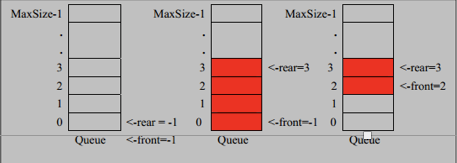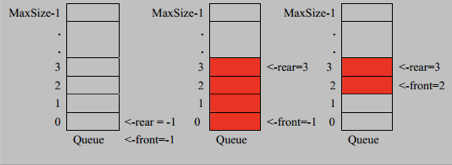?
队列介绍
1、队列是一个有序列表,可以用数组或是链表来实现
2、遵循先入先出的原则。即:先存入队列的数据,要先取出。后存入的要后取出
示意图:(使用数组模拟队列示意图)

?
数组模拟队列
队列本身是有序列表,如使用数组的结构来存储队列的数据结构,则队列数组的生命如下图,其中maxSize是该队列的最大容量。
因为队列的输出、输入是分别从前后端来处理的,因此需要两个变量front及rear分别记录队列前后端的下标,front会随着数据输出而变化,而rear则是随着数据输入而改变,如图所示:

当我们将数据存入队列时称为”addQueue”,addQueue 的处理需要有两个步骤:思路分析
1、将尾指针往后移:rear+1 , 当front == rear 【空】
2、若尾指针 rear 小于队列的最大下标 maxSize-1,则将数据存入 rear所指的数组元素中,否则无法存入数据。 rear ?== maxSize - 1[队列满]
public class ArrayQueue {
public static void main(String[] args) {
//测试一-把
//创建-一个队列
ArrayQueue queue = new ArrayQueue(3);
String key = ""; //接收用户输入
Scanner scanner = new Scanner(System.in);//
boolean loop = true;
//输出一个菜单
while (loop) {
System.out.println("s(show):显示队列");
System.out.println("e(exit):退出程序");
System.out.println("a(add):添加数据到队列");
System.out.println("g(get):从队列取出数据");
System.out.println("h(head):查看队列头的数据");
key = scanner.next().toString();//接收-一个字符
switch (key) {
case "s":
queue.showQueue();
break;
case "a":
System.out.println("输出一个 数");
int value = scanner.nextInt();
queue.addQueue(value);
break;
case "g": //取出数据
try {
int res = queue.getQueue();
System.out.printf("取出的数据是%d\n", res);
} catch (Exception e) {
// TODO: handle exception
System.out.println(e.getMessage());
}
break;
case "h": //查看队列头的数据
try {
int res = queue.headQueue();
System.out.printf("队列头的数据是%d\n", res);
} catch (Exception e) {
// TODO: handle exception
System.out.println(e.getMessage());
}
break;
case "e": //退出
scanner.close();
loop = false;
break;
default:
break;
}
}
System.out.println("程序退出~~");
}
private int maxSize; //表示数组的最大容量
private int front; //队列头
private int rear;//队列尾
private int[] arr;//该数据用于存放数据,模拟队列
//创建队列的构造器
public ArrayQueue(int arrMaxSize) {
maxSize = arrMaxSize;
arr = new int[maxSize];
front = -1;//指向队列头部前的一个位置,分析出front 是指向队列头的前一个位置.
rear = -1;//指向队列尾,指向队列尾的数据(即就是队列最后一个数据)
}
//判断队列是否满
public boolean isFull() {
return rear == maxSize - 1;
}
//判断队列是否为空
public boolean isEmpty() {
return rear == front;
}
//添加数据到队列
public void addQueue(int n) {
//判断队列是否满
if (isFull()) {
System.out.println("队列满,不能加入数据~");
return;
}
rear++;//让rear后移
arr[rear] = n;
}
//获取队列的数据,出队列
public int getQueue() {
//判断队列是否空
if (isEmpty()) {
//通过抛出异常
throw new RuntimeException("队列空,不能取数据");
}
front++;// front后移
return arr[front];
}
//显示队列的所有数据
public void showQueue() {
//遍历
if (isEmpty()) {
System.out.println("队列空的,没有数据~~");
return;
}
for (int i = 0; i < arr.length; i++) {
System.out.printf("arr[%d]= %d\n", i, arr[i]);
}
}
// 显示队列的头数据, 注意不是取出数据
public int headQueue() {
//判断
if (isEmpty()) {
throw new RuntimeException("队列空的,没有数据~~");
}
return arr[front + 1];
}
}
?
?
对前面的数组模拟队列的优化,充分利用数组. ?因此将数组看做是一个环形的。(通过取模的方?式来实现即可)
分析说明:
尾索引的下一个为头索引时表示队列满,即将队?列容量空出一个作为约定,这个在做判断队列满的?时候需要注意 (rear + 1) % maxSize == front 满]?
rear == front [空]
?
思路如下:
1、front变量的含义做一个调整:front就只想队列的第一个元素,也就是说arr[front]就是队列的第一个元素。front的初始值为0.
2、rear变量的含义做一个调整:rear指向队列的最后一个元素的后一个位置,因为希望空出一个空间作为约定,rear的初始值为0,
3、当队列满时,条件是(rear + 1)% maxSize = front【满】
4、对队列为空时,rear = front
5、当我们这样分析,队列中有效的数据的个数:(rear + maxSize - front)% maxSize
6、我们就可以在原来的队列上得到一个环形队列
public class CircleArrayQueue {
public void main11() {
//测试一把
//创建一个队列
ArrayQueue queue = new ArrayQueue(3);
String key = ""; //接收用户输入
Scanner scanner = new Scanner(System.in);//
boolean loop = true;
//输出一个菜单
while (loop) {
System.out.println("s(show):显示队列");
System.out.println("e(exit):退出程序");
System.out.println("a(add):添加数据到队列");
System.out.println("g(get):从队列取出数据");
System.out.println("h(head):查看队列头的数据");
key = scanner.next().toString();//接收一个字符
switch (key) {
case "s":
queue.showQueue();
break;
case "a":
System.out.println("输出一-个数");
int value = scanner.nextInt();
queue.addQueue(value);
break;
case "g": //取出数据
try {
int res = queue.getQueue();
System.out.printf("取出的数据是%d\n", res);
} catch (Exception e) {
// TODO: handle exception
System.out.println(e.getMessage());
}
break;
case "h": //查看队列头的数据
try {
int res = queue.headQueue();
System.out.printf("队列头的数据是%d\n", res);
} catch (Exception e) {
// TODO: handle exception
System.out.println(e.getMessage());
break;
}
case "e": //退出
scanner.close();
loop = false;
break;
default:
break;
}
}
}
private int maxSize; //表示数组的最大容量
//front变量的含义做一一个调整: front 就指向队列的第-一个元素,也就是说arr[front] 就是队列的第一个元素front的初始值= 0
private int front;
//rear变量的含义做一个调整: rear 指向队列的最后-一个元素的后一个位置.因为希望空出一个空间做为约定rear的初始值= 0
private int rear;//队列尾
private int[] arr; //该数据用于存放数据,模拟队列
public CircleArrayQueue(int arrMaxSize) {
maxSize = arrMaxSize;
arr = new int[maxSize];
}
//判断队列是否满
public boolean isFull() {
return (rear + 1) % maxSize == front;
}
//判断队列是否为空
public boolean isEmpty() {
return rear == front;
}
//添加数据到队列
public void addQueue(int n) {
//判断队列是否满
if (isFull()) {
System.out.println("队列满,不能加入数据~");
return;
}
//直接将数据加入
arr[rear] = n;
//将rear 后移,这里必须考虑取模
rear = (rear + 1) % maxSize;
}
//获取队列的数据,出队列
public int getQueue() {
//判断队列是否空
if (isEmpty()) {
//通过抛出异常
throw new RuntimeException("队列空,不能取数据");
}
//这里需要分析出front是指向队列的第一一个元素
//1.先把front对应的值保留到--个临时变量
//2. 将front 后移,考虑取模
//3.将临时保存的变量返回
int value = arr[front];
front = (front + 1) % maxSize;
return value;
}
//显示队列的所有数据
public void showQueue() {
//遍历
if (isEmpty()) {
System.out.println("队列空的,没有数据~~");
return;
}
//思路:从front开始遍历,遍历多少个元素
//动脑筋
for (int i = front; i < front + size(); i++) {
System.out.printf("arr[%d]= %d\n", i % maxSize, arr[i % maxSize]);
}
}
//求出当前队列有效数据的个数
public int size() {
// rear= 2
// front= 1
// maxSize = 3
return (rear + maxSize - front) % maxSize;
}
//显示队列的头数据, 注意不是取出数据
public int headQueue() {
//判断
if (isEmpty()) {
throw new RuntimeException("队列空的,没有数据~~");
}
return arr[front];
}
}
?
cs



